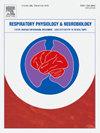Muscle oxygenation and local blood volume difference between intercostal and deltoid during dry static apnea in breath-hold divers
IF 1.6
4区 医学
Q3 PHYSIOLOGY
引用次数: 0
Abstract
During either a static or dynamic apnea, oxygen is delivered to vital organs, i.e., the brain and heart, and there is a compensatory reduction of oxygen consumption in peripheral tissues. Additionally, maximal apnea is characterised by the initial easy-going phase and subsequent struggle phase in which involuntary breathing movements appear. The aim of this study was to compare the oxygenation and local blood volume of one active (external intercostal) and one non-active (deltoid) muscle during maximal dry static apneas in breath-hold divers while supine. Thirteen breath-hold divers performed 3 preparatory apneas followed by 3 maximal apneas with 5 min of supine rest between each apnea. During all apneas (duration, 115–323 s; IBM, 7–35) muscle oxygenation and muscle blood volume change were measured via NIRS. The variables quantified were muscle oxygen saturation (SmO2) and total hemoglobin (tHb). We found that the decline in oxygen saturation was similar in external intercostals and deltoids, even though their physiological role during a breath-hold is different. However, the external intercostals re-saturated at a significantly higher rate following a maximal apnea than the deltoid muscle (p = 0.02). Also, during the apneas, there was a significantly different response between muscles, where external intercostals had an increase and deltoid a decrease in tHb (p = 0.01). These findings indicate that despite respiratory muscle activity resulting from IBMs during breath-holds external intercostal muscle re-oxygenation occurs faster than peripheral muscles which may allow for a faster return to normal breathing.
屏气潜水员在准备和最大干静态呼吸暂停期间呼吸肌和骨骼肌的肌肉氧合和局部血容量差异。
在静态或动态呼吸暂停期间,氧气被输送到重要器官,即大脑和心脏,并且周围组织的耗氧量代偿性减少。此外,最大呼吸暂停的特点是最初的轻松阶段和随后的不自主呼吸运动出现的挣扎阶段。本研究的目的是比较屏气潜水员仰卧时最大干静态呼吸时一块活跃肌肉(外肋间肌)和一块非活跃肌肉(三角肌)的氧合和局部血容量。13名屏气潜水员分别进行3次预备呼吸,然后3次最大呼吸,每次呼吸之间仰卧休息5分钟。在所有呼吸暂停(持续时间,115 - 323秒;通过近红外光谱(NIRS)测量肌肉氧合和肌肉血容量变化。定量变量为肌氧饱和度(SmO2)和总血红蛋白(tHb)。我们发现外肋间肌和三角肌的氧饱和度下降是相似的,尽管它们在屏气时的生理作用是不同的。然而,在最大呼吸暂停后,外肋间肌的再饱和率明显高于三角肌(p=0.02)。此外,在呼吸暂停期间,肌肉之间的反应也有显著差异,其中外肋间肌tHb增加,三角肌tHb减少(p=0.01)。这些发现表明,尽管呼吸暂停期间IBMs导致呼吸肌活动,但肋间肌外再氧合比周围肌肉发生得更快,这可能允许更快地恢复正常呼吸。
本文章由计算机程序翻译,如有差异,请以英文原文为准。
求助全文
约1分钟内获得全文
求助全文
来源期刊
CiteScore
4.80
自引率
8.70%
发文量
104
审稿时长
54 days
期刊介绍:
Respiratory Physiology & Neurobiology (RESPNB) publishes original articles and invited reviews concerning physiology and pathophysiology of respiration in its broadest sense.
Although a special focus is on topics in neurobiology, high quality papers in respiratory molecular and cellular biology are also welcome, as are high-quality papers in traditional areas, such as:
-Mechanics of breathing-
Gas exchange and acid-base balance-
Respiration at rest and exercise-
Respiration in unusual conditions, like high or low pressure or changes of temperature, low ambient oxygen-
Embryonic and adult respiration-
Comparative respiratory physiology.
Papers on clinical aspects, original methods, as well as theoretical papers are also considered as long as they foster the understanding of respiratory physiology and pathophysiology.

 求助内容:
求助内容: 应助结果提醒方式:
应助结果提醒方式:


